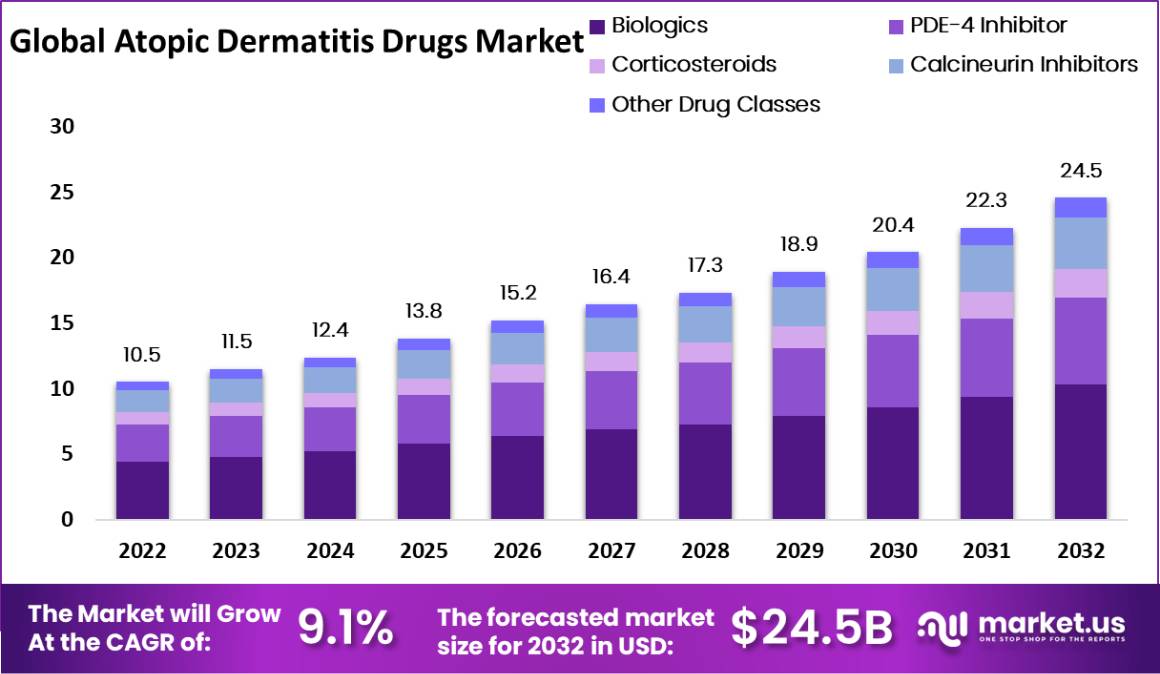Atopic Dermatitis Drugs Market Size is expected to be worth around USD 24.5 Billion by 2032 from USD 10.5 Billion in 2022, growing at a CAGR of 9.1% during the forecast period from 2022 to 2032.
 Get a sample copy of the report to know more https://market.us/report/atopic-dermatitis-drugs-market/request-sample/
Get a sample copy of the report to know more https://market.us/report/atopic-dermatitis-drugs-market/request-sample/
Key Market Segments
Based on Drug Class
- Biologics
- PDE-4 Inhibitor
- Corticosteroids
- Calcineurin Inhibitors
- Other Drug Classes
Based on the Route of Administration
- Injectable
- Topical
- Oral
Based on Distribution Channel
- Hospital Pharmacies
- Online Pharmacies
- Retail Pharmacies
Key Regions
- North America (The US, Canada, Mexico)
- Western Europe (Germany, France, The UK, Spain, Italy, Portugal, Ireland, Austria, Switzerland, Benelux, Nordic, Rest of Western Europe)
- Eastern Europe (Russia, Poland, The Czech Republic, Greece, Rest of Eastern Europe)
- APAC (China, Japan, South Korea, India, Australia & New Zealand, Indonesia, Malaysia, Philippines, Singapore, Thailand, Vietnam, Rest of APAC)
- Latin America (Brazil, Colombia, Chile, Argentina, Costa Rica, Rest of Latin America)
- Middle East & Africa (Algeria, Egypt, Israel, Kuwait, Nigeria, Saudi Arabia, South Africa, Turkey, United Arab Emirates, Rest of MEA)
Market Key Players
- Sanofi SA
- Pfizer Inc.
- AbbVie Inc.
- Eli Lilly and Company
- LEO Pharma Inc.
- Novartis AG
- Otsuka Pharmaceutical Co., Ltd.
- Regeneron Pharmaceuticals Inc.
- Other Key Players
If You Have Any Questions About This Report, Please Reach Out to Us @ https://market.us/report/atopic-dermatitis-drugs-market/#inquiry
Drivers
-
Rising Prevalence of Atopic Dermatitis: The increasing global prevalence of atopic dermatitis drives the market for its treatment. This chronic skin condition affects millions, creating a strong demand for effective medications.
-
Advancements in Biologic Therapies: The development of biologic therapies, particularly monoclonal antibodies, is transforming the treatment landscape. These targeted therapies offer better efficacy and fewer side effects compared to traditional treatments.
-
Increased Awareness and Diagnosis: Growing awareness among patients and healthcare providers about atopic dermatitis leads to early diagnosis and treatment. This awareness is further fueled by campaigns and educational programs.
-
Supportive Government Initiatives: Governments are increasingly funding research and development activities focused on skin disorders. Regulatory approvals and reimbursements for atopic dermatitis drugs also encourage market growth.
-
Expanding Research and Development: Continuous R&D efforts in developing novel therapies contribute significantly to market expansion. Pharmaceutical companies are investing heavily in discovering and commercializing new drugs.
Trends
-
Shift Towards Biologic Drugs: The market is witnessing a shift from conventional treatments to biologic drugs. Biologics are favored due to their targeted approach and improved patient outcomes.
-
Introduction of Janus Kinase (JAK) Inhibitors: JAK inhibitors are emerging as a promising class of drugs for atopic dermatitis. These small-molecule drugs are gaining traction due to their efficacy in controlling severe symptoms.
-
Rising Use of Topical Therapies: Despite advancements in systemic therapies, topical treatments remain popular. New formulations with enhanced delivery systems are being introduced, maintaining their relevance in the market.
-
Personalized Medicine Approach: The trend towards personalized medicine is growing in the atopic dermatitis market. Tailoring treatments based on genetic profiles and disease severity is expected to improve patient outcomes.
-
Increasing Mergers and Acquisitions: Pharmaceutical companies are engaging in strategic mergers and acquisitions. This trend aims to enhance their product portfolios and expand their market presence.
Opportunities
-
Untapped Emerging Markets: Emerging markets, particularly in Asia-Pacific and Latin America, offer significant growth opportunities. The rising healthcare expenditure and growing patient population in these regions drive demand for atopic dermatitis drugs.
-
Development of Novel Therapeutics: There is a significant opportunity to develop new therapeutics that address unmet needs in atopic dermatitis treatment. Innovations such as next-generation biologics and small molecules hold potential for market growth.
-
Expansion of Pediatric Treatment Options: The pediatric population is a key area of focus for market players. Developing safe and effective treatments for children with atopic dermatitis presents a substantial market opportunity.
-
Digital Health and Telemedicine Integration: The integration of digital health technologies and telemedicine into dermatology is an emerging opportunity. Remote consultations and digital monitoring can enhance patient adherence to treatment regimens.
-
Growing Demand for Natural and Organic Products: Consumers are increasingly seeking natural and organic skincare products. Developing atopic dermatitis treatments with natural ingredients could cater to this growing demand.
Restraints
-
High Cost of Biologic Therapies: The high cost of biologic therapies poses a significant barrier to market growth. These treatments are often expensive, limiting their accessibility to a broader patient base.
-
Side Effects of Current Treatments: Some atopic dermatitis drugs, particularly corticosteroids, have associated side effects. Long-term use can lead to complications, deterring patients from continuing treatment.
-
Stringent Regulatory Requirements: The regulatory landscape for atopic dermatitis drugs is stringent, especially for novel therapies. Obtaining approvals can be time-consuming and costly, affecting market entry for new products.
-
Competition from Generic Drugs: The availability of generic drugs in the market poses a challenge to branded medications. Generics offer similar efficacy at a lower cost, reducing the market share of branded drugs.
-
Lack of Awareness in Low-Income Regions: In low-income regions, there is still a lack of awareness about atopic dermatitis and its treatment options. This limits the market potential in these areas despite the high prevalence of the condition.
Contact Us :
420 Lexington Avenue, Suite 300 New York City, NY 10170,
United States
Phone:+1 718 618 4351 (International),+91 78878 22626 (Asia)
Email: inquiry@market.us






